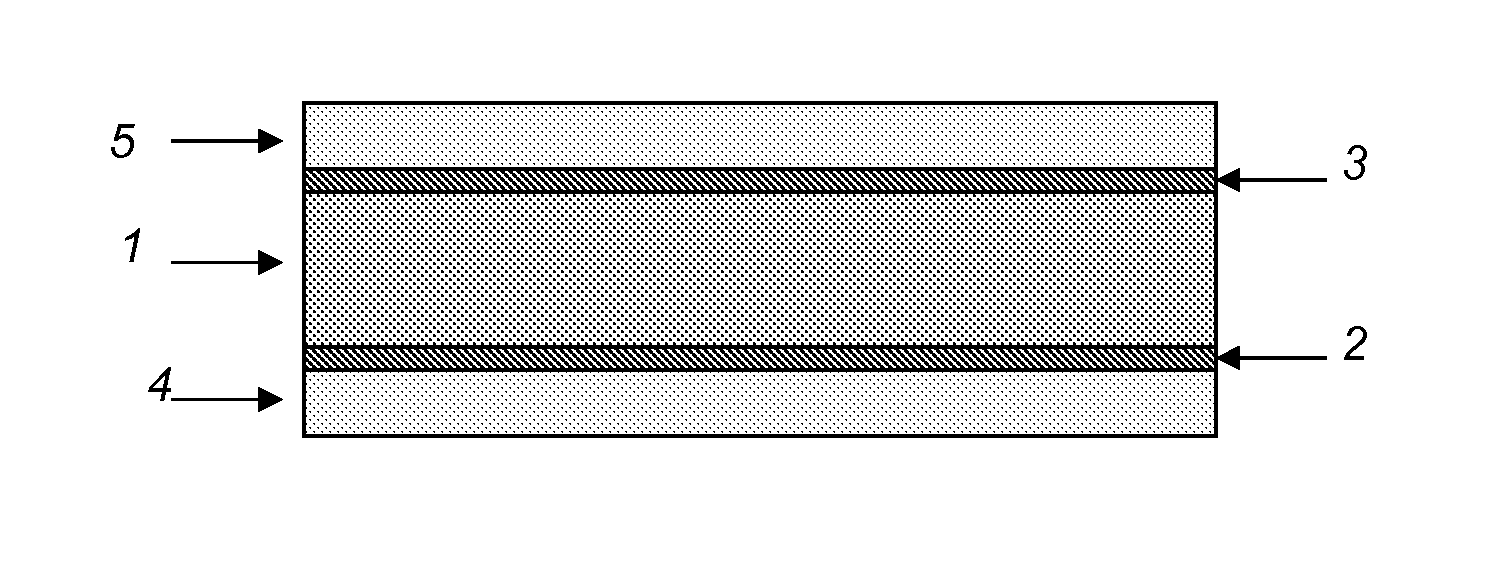Polymer backsheet of solar cell assembly and manufacturing process thereof
a solar cell and polymer technology, applied in the field of solar module polymer backsheets, can solve the problems of changing the composition of the atmosphere and deteriorating the global climate, the cost of power generation via solar cells is higher than that via traditional fossil fuels, and the cost of power generation via solar cells is still high. , to achieve the effect of improving the adhesion strength, improving the processability, and improving the mechanical performance of materials
- Summary
- Abstract
- Description
- Claims
- Application Information
AI Technical Summary
Benefits of technology
Problems solved by technology
Method used
Image
Examples
example 1
[0073]15% of PMMA and 5% of surface-treated TiO2, based on the weight of regular extrusion grade PVDF plastic granules, were added to regular extrusion grade PVDF plastic granules, and the mixture was extruded at about 200° C. in a twin-screw extruder to obtain PVDF blend plastic pellets. Ethylene-butyl acrylate (EBA) was used as the first tie layer, 5% of TiO2, 1% of silane coupling agent, 0.5% of photo stabilizer and ant ageing agent were added and mixed homogeneously in a conventional mixing machine to obtain the EBA mixture. Regular Nylon 12 was used as the basement material.
[0074]The mixture of PVDF, Nylon 12 and EBA was melt co-extruded via a multi-layer extruder at a temperature of 270° C. to obtain a four-layer laminated film of PVDF / EBA / Nylon 12 / EBA with the individual thickness of each layer as 20 / 20 / 200 / 80 μm.
[0075]The resultant solar module backsheet of PVDF / EBA / Nylon 12 / EBA has a total thickness of 320 μm.
[0076]The peeling strength between the PVDF layer and the Nylon 1...
example 2
[0081]5% of PMMA and 5% of surface-treated TiO2 were added to regular extrusion grade PVDF plastic granules, and the mixture was extruded and pelletized at about 200° C. in a twin-screw extruder to obtain PVDF blend plastic pellets. Ethylene-butyl acrylate (EBA) and PMMA were used as tie layer, and regular Nylon 12 was used as the basement material.
[0082]PVDF, PMMA, EBA and Nylon 12 were melt co-extruded via four extruders at a temperature of 270° C. to obtain a seven-layer laminated film of PVDF / PMMA / EBA / Nylon12 / EBA / PMMA / PVDF with the individual thickness of each layer of 20 / 20 / 20 / 200 / 20 / 20 / 20 μm. The resultant solar module backsheet of PVDF / PMMA / EBA / Nylon12 / EBA / PMMA / EBA / PVDF has a total thickness of 320 μm.
[0083]The peeling strength between the PVDF layer and the Nylon 12 layer of the backsheet was measured as 15 N / cm.
[0084]The backsheet, EVA and glass was composited in a vacuum laminating machine at 145° C. for 10 minutes to make the sample.
[0085]The peeling strength between the...
example 4
[0097]5% of surface-treated TiO2 was added to regular extrusion grade polychlorotrifluoroethylene (PCTFE) plastic granules, and the mixture was extruded and pelletized at about 200° C. in a twin-screw extruder to obtain PCTFE blend plastic pellets. Ethylene-butyl acrylate (EBA) was used as the first tie layer. 5% of TiO2, 1% of silane coupling agent and 0.5% of photo stabilizer and ant ageing agent were added and mixed homogeneously in a conventional mixing machine to obtain the EBA mixture. Regular Nylon 12 was used as the basement material.
[0098]The mixture of Nylon 12 and EBA was melt co-extruded via a multi-layer extruder at a temperature of 270° C. to obtain the two-layer laminated film of Nylon 12 / EBA with the individual thickness of each layer as 200 / 80 μm.
[0099]The mixture of PCTFE plastic granules and EBA was melt co-extruded at a temperature of 270° C. via a two-layer extruder onto the prepared Nylon 12 / EBA two-layer laminated film, and then composited via roll pressing to...
PUM
| Property | Measurement | Unit |
|---|---|---|
| Thickness | aaaaa | aaaaa |
| Thickness | aaaaa | aaaaa |
| Electrical resistance | aaaaa | aaaaa |
Abstract
Description
Claims
Application Information
 Login to View More
Login to View More - R&D
- Intellectual Property
- Life Sciences
- Materials
- Tech Scout
- Unparalleled Data Quality
- Higher Quality Content
- 60% Fewer Hallucinations
Browse by: Latest US Patents, China's latest patents, Technical Efficacy Thesaurus, Application Domain, Technology Topic, Popular Technical Reports.
© 2025 PatSnap. All rights reserved.Legal|Privacy policy|Modern Slavery Act Transparency Statement|Sitemap|About US| Contact US: help@patsnap.com


